
Prince Eugene Francis of Savoy–Carignano, better known as Prince Eugene, was a field marshal in the army of the Holy Roman Empire and of the Austrian Habsburg dynasty during the 17th and 18th centuries. He was one of the most successful military commanders of his time, and rose to the highest offices of state at the Imperial court in Vienna.
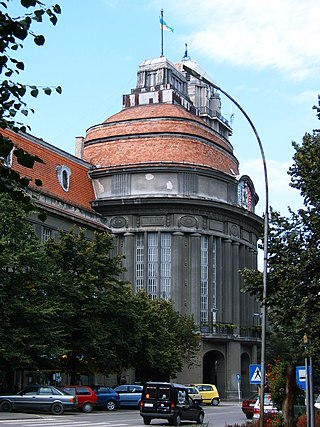
Senta is a town and municipality located in the North Banat District of the autonomous province of Vojvodina, Serbia. It is situated on the bank of the Tisa river in the geographical region of Bačka. The town has a population of 18,704, whilst the Senta municipality has 23,316 inhabitants.
This article is about the history of Sarajevo in Bosnia and Herzegovina.
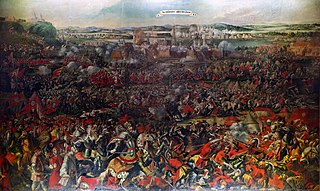
The Great Turkish War, also called the Wars of the Holy League, was a series of conflicts between the Ottoman Empire and the Holy League consisting of the Holy Roman Empire, Poland-Lithuania, Venice, Russia, and the Kingdom of Hungary. Intensive fighting began in 1683 and ended with the signing of the Treaty of Karlowitz in 1699. The war was a defeat for the Ottoman Empire, which for the first time lost large amounts of territory, in Hungary and the Polish–Lithuanian Commonwealth, as well as part of the western Balkans. The war was significant also by being the first time that Russia was involved in an alliance with Western Europe.

The Battle of Zenta, also known as the Battle of Senta, was fought on 11 September 1697, near Zenta, Kingdom of Hungary, between Ottoman and Holy League armies during the Great Turkish War. The battle was the most decisive engagement of the war, and it saw the Ottomans suffer an overwhelming defeat by an Imperial force half as large sent by Emperor Leopold I.

The Battle of Petrovaradin also known as the Battle of Peterwardein, took place on 5 August 1716 during the Austro-Turkish War when the Ottoman army besieged the Habsburgs-controlled fortress of Petrovaradin on the Military Frontier of the Habsburg monarchy. The Ottomans attempted to capture Petrovaradin, the so-called Gibraltar on the Danube, but experienced a great defeat by an army half the size of their own, similar to the defeat they had experienced in 1697 at Zenta. Ottoman Grand Vizier Damad Ali Pasha was fatally wounded, while the Ottoman army lost 20,000 men and 250 guns to the Habsburg army led by Field Marshal Prince Eugene of Savoy.

The Ottoman Empire era of rule in Bosnia and Herzegovina and Herzegovina lasted from 1463/1482 to 1878 de facto, and until 1908 de jure.
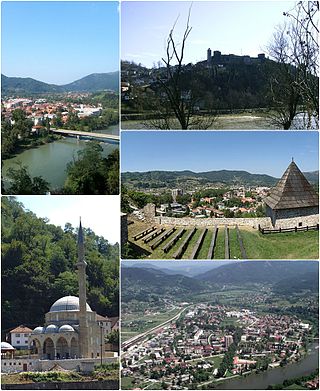
Maglaj is a town and municipality located in the Zenica-Doboj Canton of the Federation of Bosnia and Herzegovina, an entity of Bosnia and Herzegovina. It is located in northern Bosnia and Herzegovina, 25 km (16 mi) south of Doboj. It has a population of 6,438, with 34,980 inhabitants in the municipality.
Bosniaks are a South Slavic ethnic group, native to Bosnia and Herzegovina and the region of Sandžak. The term Bosniaks was re-instated in 1993 after decades of suppression in the Socialist Federal Republic of Yugoslavia. The Bosniak Assembly adopted the ethnonym to replace "Bosnian Muslims." Scholars believe that the move was partly motivated by a desire to distinguish the Bosniaks from the fabricated and imposed term Muslim to describe their nationality in the former Yugoslavia. These scholars contend that the Bosniaks are distinguishable from comparable groups due to a collective identity based on a shared environment, cultural practices and experiences.

Doboj Fortress or Gradina (Градина) is located in the city of Doboj, Bosnia and Herzegovina. Throughout its turbulent history, the fortress has been burned and ransacked at least 18 times as per official records. Of note is that Doboj fortress was considered to be a royal Kotromanić property, unlike Great Bosnian Duke Hrvoje's Zvečaj fortress or Sandalj Hranić's Blagaj fortress, which were centers of their respective duchies.

Stjepan Freiherr Sarkotić von Lovćen was an Austro-Hungarian Army generaloberst of Croatian descent who served as Governor of Bosnia and Herzegovina and military commander of Dalmatia and Montenegro during the First World War.
The Battle of Banja Luka took place in Banja Luka, Ottoman Bosnia, on 4 August 1737, during the Austro-Russian-Turkish War. An Austrian army under Prince Joseph Hildberghausen was defeated, as it attempted to besiege the town, when it ran into a large Ottoman relief force led by Bosnian Vizier Hekimoğlu Ali Pasha.

The siege of Belgrade was a successful attempt by Imperial Habsburg troops under the command of the Elector of Bavaria Maximilian II Emanuel to capture the city of Belgrade from the Ottoman Empire. The capture took place on 6 September 1688, after a month of siege, during the Great Turkish War (1683–1699). By conquering Belgrade, the Imperialists gained an important strategic outpost, as the city had been the Ottoman's chief fortress in Europe, for more than a century and a half. The Turks recaptured it two years later only to lose it again to Eugene of Savoy in 1717.
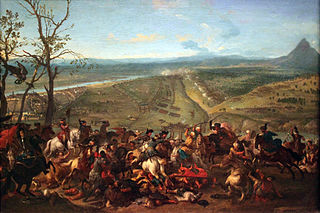
The siege of Belgrade was a successful attempt by Austrian troops under the command of Prince Eugene of Savoy to capture the strategically important city of Belgrade from the Ottoman Empire. It took place during the Seventh Ottoman–Venetian War (1714–1718), barely a year after the Austrian victory at the Battle of Petrovaradin (Peterwardein). The Austrians routed the Ottoman relief army under Grand Vizier Hacı Halil Pasha on 16 August. As a consequence, the Belgrade garrison, deprived of relief, surrendered to the Austrians on 21 August. The Ottoman Sultan Ahmed III sued for peace, resulting in the Treaty of Passarowitz a year later, which completed the transfer of the remainder of Hungary, the Banat and the city of Belgrade into Austrian hands.

The Battle of Olasch took place after a Habsburg Imperial army led by Saxon Elector General, Augustus II the Strong, laid siege to Turkish held Temesvár. On 26 August 1696, after learning that Sultan Mustafa II's relief army was crossing the Danube at Pancsova, Augustus gave up the siege and headed to meet the Ottoman army. The battle near the Bega River resulted in a draw after both armies retreated with heavy casualties on both sides. Strategically, the Ottoman army's campaign can be considered a success, as it achieved its goal of retaining Temesvár.

The campaign to establish Austro-Hungarian rule in Bosnia and Herzegovina lasted from 29 July to 20 October 1878 against the local resistance fighters supported by the Ottoman Empire. The Austro-Hungarian Army entered the country in two large movements: one from the north into Bosnia, and another from the south into Herzegovina. A series of battles in August culminated in the fall of Sarajevo on the 19th after a day of street-to-street fighting. In the hilly countryside a guerrilla campaign continued until the last rebel stronghold fell after their leader was captured.

Jovan Popović Tekelija was a Serb army officer serving in the Habsburg army. As commander of the Serbian Militia, Tekelija participated in many battles distinguishing himself in particular during the Battle of Zenta in 1697 where the Ottoman Empire suffered a stunning defeat. For his merit, he was appointed Captain of the Serbian militia in Arad and ennobled by Emperor Joseph I.
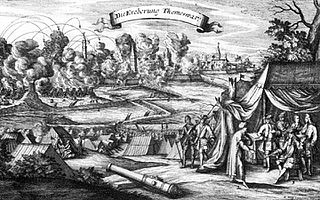
The siege of Temeşvar took place from 31 August to 12 October 1716 during the Austro-Turkish War of 1716-1718. The Habsburg army led by Prince Eugene of Savoy, who had just won a crushing victory at Petrovaradin, managed to capture the fortress of Temeşvar an Ottoman stronghold since 1552, the capital of the Banat and the last Turkish stronghold in Hungary. The garrison capitulated after a 43 days siege. The city remained under military administration until 6 June 1778, when it was handed over to the administration of the Kingdom of Hungary.
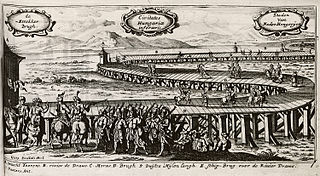
Croatian-Slavonian theater in Great Turkish War, concerns military operations undertaken during Great Turkish War of 1684-1689 by the forces of Holy League against the Ottoman Empire on territories of Croatia, Slavonia and Dalmatia. The war was concluded by Treaty of Karlowitz in 1699, which significantly eased off the Ottoman grip off Croatia.

Siege of Bihać (1697) was a Habsburg siege of Ottoman town of Bihać in Bosnian Krajina. The siege was planned as a diversionary attack from main Habsburg offensive on Danube river, and was called off after several failed storming attempts.





















